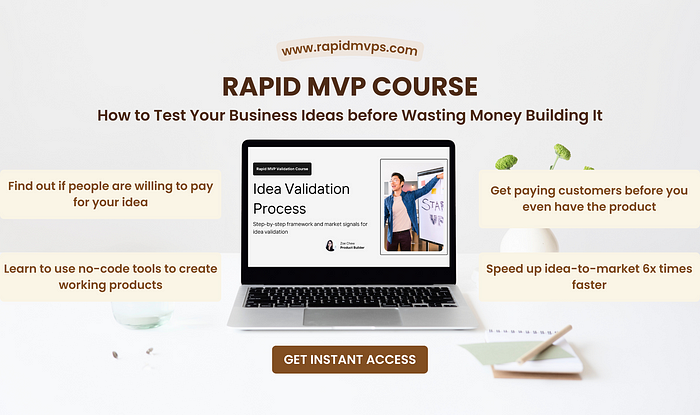How to test market demand for your business ideas?
I help entrepreneurs and builders to ideate, validate, and plan their MVPs. You may also like my top-rated guides such as— Profitable SaaS Ideas, Minimum Viable Market & NoCode MVPs ! ✍️Join my free newsletter to receive these insights in your inbox!

Whether it’s a startup, mobile app, software or online services, many new digital products struggle to reach the market successfully, i.e. acquiring early paying customers and eventually discovering product-market fit.
The primary reason for this is that new entrepreneurs often dive straight into developing “untested ideas.”
This can lead to creating a solution that doesn’t match the problem or the target customers.
The solution is simple: test if people are willing to pay before making the actual product.
I call this the Rapid MVP Validation method:
It’s a step-by-step process for developing high-impact market testing experiments using low-cost minimum solution to test your product ideas and boost your chances of creating something people are willing to pay for.
This post contains excerpts from my the Rapid MVP Validation method.
I will share some guiding frameworks for evaluating whether people are willing to pay for your product ideas. Let’s go 🙌

Key insight #1: Problem & Solution-Awareness
Before you create any prototypes or MVPs to evaluate people’s desire to pay, you need be clear about:
What types of evidence do we look for when approaching potential customers?
In the early stages, the evidence or goal of the experiment is to find problem and solution awareness.
Creating customer hypotheses and talking to potential customers might help you delve further into what you want to uncover.
Formula for creating your customer hypothesis:
[My Target customer] have this [problem] that I can solve with [this solution]
A customer hypothesis is an initial guess about your target customer needs, pain points, and behaviors that must be verified.
You are going to think through multiple aspects of the customers’ problem, for example:
- you want to confirm that this problem is real
- this specific target market cares about this pain point
- also want to make sure people are already using existing or alternative solution to solve this problem
- and then to find out if they are willing to pay for your product idea
Key insight #2: Create experiments to test
Once you have thoroughly understood who your potential customers are, create market testing experiments that match the purpose of your validation goal, i.e. the evidence you want to find out.
In the Rapid MVP course, I’ve discussed the differences between minimal viable test and minimum viable product (MVP), as well as when they should be used for maximum impact.
For sneak peek, here are some key takeaway:
- Test before you build. Not build first, then figure out what’s missing and endlessly tweak the product without specific goals.
- Avoid falling into the MVP “feature trap.” This occurs when you build a solution without a clear problem, continually add more features, endlessly fix the MVP, and never truly validate a startup idea.
- Figure out the “most dangerous factors” that could affect the VIABILITY of your product ideas by using the rapid experiment techniques.
- Choose the right market testing experiments or MVPs based on stages of your product validation.
Key insight #3: Signs of market validation
After completing validation experiments, you will analyze feedback, behavioral patterns, and data to decide whether your product idea has been validated or invalidated.
In other words:
- How can you tell if your startup idea is validated?
- What metrics should you look for to indicate people are willing to pay for your idea?
- If you want to validate new features, what signals should you be on the lookout for?
For sneak peek, here are some key takeaways:
- Validating your product idea isn’t about seeking opinions from friends, colleagues, or investors. Instead, focus on observing their actions. Ask yourself: Did they attempt to use your product, or did they pay for it?
- A clear signal of validating a viable problem is when you can identify a substantial number of people in your user interviews who are spending money to address the problem you’re trying to solve.
- A clear indication of validating a viable solution is when your product becomes so valuable that users prefer it over existing solutions.
Access the Rapid MVP Course 🥳
Watch the free 25-minute video excerpts of the Rapid MVP Validation course, click here 👈 :::

